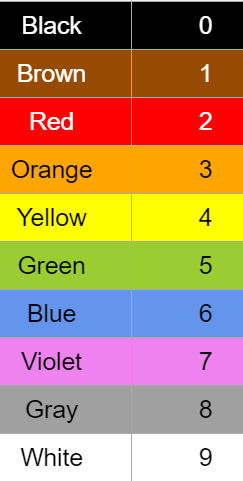Resistance Is Not Futile
Electronics as applied to digital devices has a different emphasis to general electronics. One of the big differences is that you can mostly get away with just knowing about resistors and Ohm's law. You do need to know a little about some other devices like transistors, FETs, LEDs and so on but really it is the resistor that gives you most of your problems.
You will find that the only calculations you have to do are in selecting the correct resistor to set the current following or as we shall see to reduce a voltage.
In short - you are going to be using resistors as one of your basic building blocks.
Before moving on we need to discover a little about real world resistors.
A resistor is a fairly simple device. They are made in many different ways but you can more or less ignore what a resistor is made from in most digital applications. They also come in a number of different shapes and sizes but the one you will most often use is the common "through hole" or wire ended resistor:

If you start to build advanced devices then you will also encounter surface mount resistors but in this introductory book we will ignore this form of packaging.
A resistor differs in its resistance, its accuracy and its power handling capacity.
Obviously you need a resistor to be close to the resistance value you have calculated but resistors are not made with 100% accuracy. Typically a resistor will be within 20%, 10%, 5% and so on. Obviously the cost of a resistor depends on how accurate it is.For most digital applications a 5% tolerance is more than good enough.
Next we come to the topic of preferred values.
You can't ask for a resistor of any value you care to calculate. There is no resistor with a resistance of 314.159 Ohms. The reason is obvious in that you would need to manufacture an infinite set of resistors to satisfy every need. It also isn't necessary because if your resistors are only 10% accurate your 314.159 Ohm could be as big as 345 Ohm or as small as 283 Ohm.
What manufacturers do is to create a series of values that covers the possible range taking account of the tolerance. For example the E6 series has the values
10 15 22 33 47 68
and this covers the range 0 to 100 in 20% intervals. If you are working with 20% resistors you calculate the value you want 314.159 Ohms and then select the closest E6 series value - 330 Ohms in this case.
For a typical 5% resistor used in digital design the preferred values are taken from the E24 series:
10 12 15 18 22 27 33 39 47 56 68 82 11 13 16 20 24 30 36 43 51 62 75 91
And in this case the closest resistor to 314.159 Ohms is 300 Ohms.
Don't become obsessed by the need to get a resistor that is exactly what you calculate. Electronic components are tolerant of small changes and the E24 series is usually more than enough resistors.
Power handling capacity of a resistor simply sets the amount of current that a resistor can take without bursting into flames. When electricity flows things heat up. The amount of power a resistor can dissipate is given in Watts and you can find the number of Watts a resistor has to dissipate using the formula:
P=I2R
For example the resistor in our previous circuit has a current of
I=0.6 A
and a resistance of 50 Ohms so it is dissipating
(0.6)2 * 50 W
or 18 Watts - which for a digital circuit is a lot of power.
Typical resistors used in digital electronics are never called on to work with more than 0.25W - the reason is that you generally want to design your circuits to consume as little power as possible.
However it is worth keeping in mind that if you do design something that runs a large motor a heater or a bright light source any resistors used could be called on to carry more than the typical 0.25W resistor. You may need to buy something special!
Finally - how do you determine the resistance of a particular resistor?
The answer is the infamous color code.
Being able to read a color code is a mark that you are an electronics engineer. However today you can get by with a good multimeter that will measure the resistance of the device in front of you.
The only thing you need to learn is the following table:

You use this code to read the value of a resistor in a fairly obvious way. The first two colored bands give you the first two significant digits of the value and the third gives its magnitude. For example the resistor shown below;

has a yellow and an violet first and second band so its value is 47. The third band is red which is 2 and so the magnitude is 102 or a 100. So the value of the resistor is 47*100 or 4700 or 4.7K Ohms.
There are lots of resistor color code decoders on the web and if you are short of a project it doesn't take long to implement one.
The only problem that you might have is working out which end to start reading the colors from. There is usually a bigger gap and the end of the colored bands. Alternatively you can look out for the gold or silver 1% or 5% tolerance indicators.
In the last resort if you are uncertain about the value of a resistor you can always measure its resistance with a multi-meter.

